- Data extracted in March 2018. Most recent data: Further Eurostat information, Main tables and Database. Planned article update: April 2019.
This article is part of an online publication and provides information on a range of statistics related to the environment for the European Union (EU) enlargement countries, in other words the candidate countries and potential candidates. Montenegro, the former Yugoslav Republic of Macedonia, Albania, Serbia and Turkey currently have candidate country status, while Bosnia and Herzegovina and Kosovo [1] are potential candidates.
This article provides some information in relation to climate change, waste and water, presenting indicators such as the level of greenhouse gas emissions, municipal waste generated and waste treated, and water abstraction.
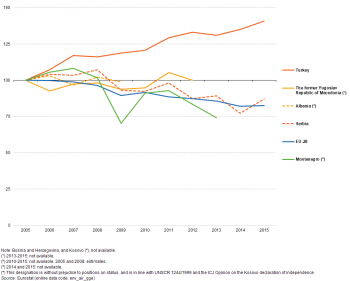
(2005 = 100; based on CO2 equivalents)
Source: Eurostat (env_air_gge)
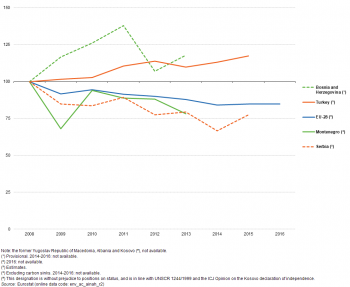
(2008 = 100)
Source: Eurostat (env_ac_ainah_r2)
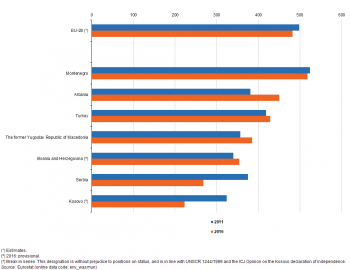
(kilograms per inhabitant)
Source: Eurostat (env_wasmun)
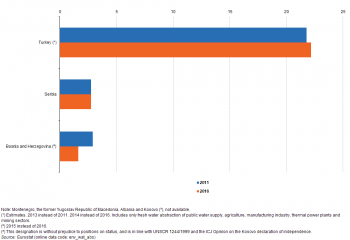
(%)
Source: Eurostat (env_wat_abs)
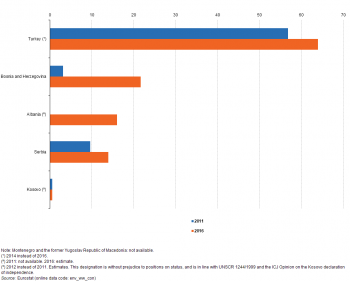
(%)
Source: Eurostat (env_ww_con)
Main statistical findings
Greenhouse gas and carbon dioxide emissions
The gases considered in this article as greenhouse gases are carbon dioxide (CO2), nitrous oxide (N2O), methane (CH4), hydrofluorocarbons (HFCs), perfluorocarbons (PFCs) and sulphur hexafluoride (SF6). The indicator in Figure 1 shows the combined trend in emissions of these gases. The basic data are annual emissions estimated and reported according to the Intergovernmental Panel on Climate Change (IPCC) guidelines.
The index for total greenhouse gas emissions in the EU-28 reflects a regular fall in such emissions, with a particularly large fall in 2009, in large part related to the global financial and economic crisis and the associated reduction in levels of industrial activity, followed by a rebound in 2010. By 2015, the index was 17.3 % lower than it had been in 2005.
The time series for Turkey reflects an almost unbroken increase in greenhouse gas emissions during the period shown — therefore also during the crisis — with the only fall recorded in 2013; the overall increase in emissions in Turkey between 2005 and 2015 was 40.9 %. The time series for the former Yugoslav Republic of Macedonia and Albania are shorter, running until 2012 and 2009 respectively. These both show a rather inconsistent development, with neither increases nor decreases dominating. Like the EU-28, Serbia and Montenegro recorded an overall decline in greenhouse gas emissions after 2005 (time series available until 2015 for Serbia and 2013 for Montenegro), with a particularly strong fall in 2009 in Montenegro, reflecting the large fall in industrial output observed there during the crisis.
Carbon dioxide is one of the greenhouse gases: while it has the lowest global warming potential of the six greenhouse gases, emissions of this gas in the EU-28 were considerably higher than for any of the other greenhouse gases such that, even when adjusted for global warming potential, emissions of carbon dioxide were far greater than for any of the other greenhouse gases. As a consequence, the developments shown in Figure 2 reflect to a large extent those seen in Figure 1. Data are available for carbon dioxide emissions for Bosnia and Herzegovina (unlike for all greenhouse gases) and these show a strong increase between 2008 and 2011 — far greater than in Turkey for comparison — followed by a very sharp fall in 2012 and a return to an increase in emissions in 2013.
Municipal waste
Municipal waste is mainly produced by households, though similar wastes from sources such as distributive trades, offices and public institutions are included; waste from agriculture and from industry is excluded from this indicator. The amount of municipal waste generated consists of waste collected by or on behalf of municipal authorities and disposed of through the waste management system. For areas not covered by a municipal waste collection scheme the reporting countries estimate the amount of waste generated.
In 2016, the average amount of municipal waste generated per inhabitant in the EU-28 was 482 kilograms (kg), in other words, just under half a tonne. This represented a fall of 16 kg per inhabitant in the quantity of waste generated in the EU-28 compared with 2011. Among the enlargement countries, the average quantity of municipal waste ranged from 223 kg per inhabitant in Kosovo to 451 kg per inhabitant in Albania, with Montenegro (518 kg per inhabitant) above this range (and also above the EU-28 average) — see Figure 3. The quantity of municipal waste generated per inhabitant increased in Albania, the former Yugoslav Republic of Macedonia, Bosnia and Herzegovina and Turkey, while it fell greatly in Serbia and Kosovo (not that there was a break in series) and slightly in Montenegro.
Waste can be treated in a number of ways, with waste treatment processes categorised either as disposal (including for example, landfill and incineration without energy recovery) or as recovery (including for example, material recycling, composting and incineration with energy recovery). For the enlargement countries data are collected for all types of incineration (with and without energy recovery) as well as for the remainder of disposal and the remainder of recovery, as can be seen from Table 1. In the EU-28, some 6.1 % of waste was incinerated, with a fairly even split of the remainder between disposal (47.4 %) and recovery (46.4 %) in 2014. In most enlargement countries (no data available for Kosovo), the proportion of waste treated by recovery (other than energy recovery) was relatively low; Turkey was a notable exception as 29.0 % of its waste in 2014 was treated by (non-energy) recovery. As incineration was not widespread among the enlargement countries — its share peaking at 5.3 % in Albania in 2016 — the vast majority of waste was treated in these countries by disposal.
The proportion of households from which household waste is regularly collected by or on behalf of municipal authorities was quite similar across the enlargement countries, ranging from 68 % (2013 data) in Albania to 82 % in Serbia, with the proportion in Turkey (92 %) above this range. In all of the enlargement countries for which data are available, the proportion of households from which waste was regularly collected increased between the years shown in Figure 4.
Water and wastewater
Freshwater abstraction as a percentage of available resources (as shown in Figure 5) is based on the resources available over the long term, a minimum of 20 years. For the three candidate countries for which data are available, this ratio ranged from just 1.6 % in Bosnia and Herzegovina in 2015 and 2.7 % in Serbia in 2016 to 22.2 % in Turkey in 2014.
In all but one of the five enlargement countries shown in Figure 6 the proportion of the population connected to urban wastewater treatment systems was relatively low, only standing above one quarter in Turkey, where it reached 64 % in 2014. However, the share of the population connected to urban wastewater treatment systems increased in the four enlargement countries for which a comparison is available, most notably in Bosnia and Herzegovina.
Data sources and availability
Data for the enlargement countries are collected for a wide range of indicators each year through a questionnaire that is sent by Eurostat to partner countries which have either the status of candidate countries or potential candidates. A network of contacts in each country has been established for updating these questionnaires, generally within the national statistical offices, but potentially including representatives of other data-producing organisations (for example, central banks or government ministries). The statistics shown in this article are made available free-of-charge on Eurostat’s website, together with other socio-economic indicators collected as part of this initiative.
Eurostat, in close partnership with the European Environment Agency (EEA), provides environmental statistics, accounts and indicators supporting the development, implementation, monitoring and evaluation of the EU’s environmental policies, strategies and initiatives. Data on greenhouse gas emissions as reported under the United Nations framework convention on climate change (UNFCCC) are collected by the EEA. Eurostat collects official statistics in relation to a broad selection of subject areas, for example, waste, water, material flows and environmental protection expenditure.
The Kyoto Protocol, an environmental agreement adopted by many of the parties to the UNFCCC in 1997 to curb global warming, covers six greenhouse gases: carbon dioxide (CO2), methane (CH4) and nitrous oxide (N2O), which are non-fluorinated gases, and hydrofluorocarbons (HFCs), perfluorocarbons (PFCs) and sulphur hexafluoride (SF6), which are fluorinated gases. Converting them to carbon dioxide equivalents makes it possible to compare them and to determine their individual and total contributions to global warming. A new agreement on greenhouse gas emissions was reached in Paris in late 2015; this provides the basis for emissions mitigation and adaptation from 2020 onwards.
Eurostat’s data on waste is collected from EU Member States on the basis of a Regulation on waste statistics (2150/2002/EC) and is published every two years in line with common methodological recommendations. Landfill is the deposit of waste into or onto land; it includes specially engineered landfill sites and temporary storage of over one year on permanent sites. The definition covers both landfill in internal sites, in other words, where a generator of waste is carrying out its own waste disposal at the place of generation, and in external sites.
Tables in this article use the following notation:
| Value in italics | data value is forecasted, provisional or estimated and is therefore likely to change; |
| : | not available. |
Context
The key objectives of the EU’s environmental policy are:
- to protect, conserve and enhance the EU’s natural capital;
- to turn the EU into a resource-efficient, green, and competitive low-carbon economy;
- to safeguard the EU’s citizens from environment-related pressures and risks to health and well-being.
The Europe 2020 strategy for smart, sustainable and inclusive growth was adopted in 2010. One of its flagship initiatives concerns resource-efficient Europe, while there are three specific targets related to the environment and climate change to be achieved by 2020, namely:
- greenhouse gas emissions should fall to 20 % lower than in 1990;
- 20 % of the energy used in the EU should be from renewables; and
- there should be a 20 % increase in energy efficiency.
Environment action programmes have guided the development of the EU’s environment policy since the early 1970s. The current EU environment action programme — referred to as the 7th EAP — was adopted by Decision 1386/2013 of the European Parliament and Council in November 2013 under the title Living well, within the limits of our planet.
While basic principles and institutional frameworks for producing statistics are already in place, the enlargement countries are expected to increase progressively the volume and quality of their data and to transmit these data to Eurostat in the context of the EU enlargement process. EU standards in the field of statistics require the existence of a statistical infrastructure based on principles such as professional independence, impartiality, relevance, confidentiality of individual data and easy access to official statistics; they cover methodology, classifications and standards for production.
Eurostat has the responsibility to ensure that statistical production of the enlargement countries complies with the EU acquis in the field of statistics. To do so, Eurostat supports the national statistical offices and other producers of official statistics through a range of initiatives, such as pilot surveys, training courses, traineeships, study visits, workshops and seminars, and participation in meetings within the European statistical system (ESS). The ultimate goal is the provision of harmonised, high-quality data that conforms to European and international standards.
Additional information on statistical cooperation with the enlargement countries is provided here.
See also
- Enlargement countries — statistical overview — online publication
- Statistical cooperation — online publication
- All articles on environment
- Greenhouse gas emission statistics
- Municipal waste statistics
Further Eurostat information
Publications
- Statistical books/pocketbooks
- Key figures on enlargement countries — 2017 edition
- Key figures on the enlargement countries — 2014 edition
- Energy, transport and environment indicators — 2017 edition
- Leaflets
- Basic figures on enlargement countries — 2016 edition
- Basic figures on enlargement countries — 2015 edition
Database
- Environment and energy (cpc_en)
- Candidate countries and potential candidates: climate change and waste (cpc_enclimwa)
- Greenhouse gas emissions by source sector (source: EEA) (env_air_gge)
- Air emissions accounts by NACE Rev. 2 activity (env_ac_ainah_r2)
- Air emissions accounts by NACE Rev. 1.1 activity (env_ac_ainah_r1)
Dedicated section
Methodology / Metadata
- Candidate countries and potential candidates (cpc) (ESMS metadata file — cpc_esms)
- Greenhouse gas emissions by source sector (source: EEA) (ESMS metadata file — env_air_gge)
- Air emissions accounts and intensities (ESMS metadata file — env_ac_ainah_r2)
Source data for tables and figures (MS Excel)
External links
- European Commission — European Neighbourhood Policy and Enlargement Negotiations
- European Commission — Environment
- European Commission — Waste
- European Commission — Energy union and climate
- European Commission — Climate action
Notes
- ↑ This designation is without prejudice to positions on status, and is in line with UNSCR 1244/1999 and the ICJ Opinion on the Kosovo declaration of independence.


